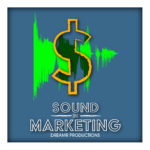Making Something Familiar Brand New
Sound is something that has been ever present in our lives. All of our lives. It is all around us telling us what to do. An alarm goes off; sound tells us to wake up. A car horn honks, sound tells us the light might have just changed without us noticing or we may have just cut someone off. The chip reader beeps; sound tells us we’ve just made a successful purchase. And in enters the subtlety of sound marketing.
Sound tells us what to do or gives us assurance that we’ve just completed something…like a transaction.
Starting from scratch and “interrupting” the space of what’s organically growing as familiar to you and your consumers is hardly ever a good idea. Taking something familiar, stripping it down to find the essence of what makes it likeable and relatable and “on brand”, and creating something brand new and established at the same time…well that’s just smart.
Consider Your Consumer in Branding
Whether you’re starting from scratch or re-branding, you should have some semblance of your ideal consumer in your head or on paper and your branding should always reflect that person. Alongside deciding if they’re male or female, old or young, their occupation and income, you should also be considering what they are listening to. In this day and age, you, me, everyone is listening to a lot. And it’s not just music. From the moment we wake up to the moment we fall asleep; sound surrounds us.
Chemical Brothers and Formula One Partnership
Like them or not The Chemical Brothers and Formula 1 just formed what I see as an excellent partnership that benefited both parties. Tom Rowlands and Ed Simons aka The Chemical Brothers are longtime Formula 1 fans. They were approached by Formula 1 to design a sonic branding. The duo accepted and created what they are deeming “the fastest remix of all time”. They took the track “We’ve Got To Try” off of their upcoming album No Geography and sped it up 15,000 beats per minute.
The significance. It was to model the 15,000 rpm’s that a Formula 1 car is capable of doing. 3 seconds long, the “remix” will launch as the global sonic branding for Formula 1. They will also use No Geography as their sonic guide for their upcoming F1 2019 season.
The Power of the Partnership
Maybe you already get why this is so smart but just in case I’ll lay out my thoughts. Both Formula 1 and The Chemical Brothers have so much to gain from this. For instance, the band are fans. What better musicians to choose to create your sound, then fans?! Being fans, they are more likely to talk about the partnership to their fans (aka me) that may not necessarily have anything to do with Formula 1 (aka me), and at least create a slight intrigue on what they’re all about. That creates a larger market for Formula 1.
Here are some ways that it benefits The Chemical Brothers. The first obvious one is, they got a commission off of it. I have no idea if they sold copyright or retain royalties or any of that but, they got paid. Secondly, they’re getting free press and record spins on their upcoming album. And as I mentioned before with Formula 1 potentially acquiring Chemical Brothers fans, the same goes for Chemical Brothers potentially acquiring Formula 1 fans. It’s a win win. So simple but brilliant at the same time.
Another way that I see this as being beneficial in the long run is when Formula 1 wants to re-brand or re-develop or update their sonic identity, they have this band that already gets them, that have already worked for them, and that is just as invested as them to come up with something great.
Custom Vs. Popular Music
Those companies that actually have the bigger budget can still get the “popular artist” that they enjoy and think can bring something to their brand and then recruit them to “do their thing” and create something unique that is not tied to their own brand but has the flair of the brand. You get a product that is new with a flair of familiar.
This is different than choosing the latest top 40 track on Billboard and incorporating it into your brand or marketing campaign. The danger in this is. One, you’ve chosen a song that already has its own identity. And that identity is attached to that artist. Two, once that artist or that song becomes irrelevant, so does your marketing attached to it.
According to a recent Nielsen survey, 75% of Americans choose music as their top form of entertainment. That’s above TV by 2%. This is where we should be focusing our marketing dollars; the music of the people. With that much influence, why not focus some attention on popular music.
For those of us with smaller pocket books let’s think of it even more simplistically. What are people listening to? Say Cardi B or Ed Sheeren or Khalif? Now let’s break it down (and this is of course subjective, but a good exercise) Why are they listening? Is it truly for the music (because sometimes it is not)? And if it is for the music, what is that “it” factor?
If you’re not a fan of the artist or the genre, don’t let that stop you. Hit up a Facebook group or friends or family. Ask them. In fact, ask a lot of people. Cull all that information together and see what is the common factor. From that, search out that sort of music from music libraries or friends that write music.
You don’t have to license Cardi B to get the Cardi B effect.
Compliment Your Brand
On top of finding out what the “it factor” is on that track or artist, find out what they have that complements your brand and vice versa. If you can’t find anything, then don’t go that route. Cardi B may be popular but if she’s not speaking to you and your audience, you’re doing yourself a disservice and creating an insincerity. And insincerity breeds lack of trust, which leads to your consumer becoming disinterested and finding someone new.
If you’re not sure what I mean by insincerity, think of your visual logo. If on every different page of your website, your brand logo is different, that’s insincerity. If you have a different logo for every different piece of social media that you manage, that’s insincerity. Insincerity is created by the lack of uniformity in your message.
Voice Commerce
One great reason or argument for developing a sound for your brand is cross promotion between the visual marketplace and the ever increasing voice marketplace.
What I’m talking primarily about here is voice commerce.
According to eMarketer, “voice commerce accounted for $2.1 billion in 2018, representing just 0.4% of online sales.”
Voice commerce is primarily thought of in the realm of Amazon marketplace but I believe it’s so much more than that. What’s happening right now is Alexa is learning products but I think it’s learning much much more. So with that being said, everyone who has a business, of any kind, needs to be in on this. I need to be in on this.
For example. I have a service. I’m an audio editor and producer for things like podcasts and such and I also write custom music and sound identities. My primary work is business to business but I also license directly to consumers where they can buy my music from online marketplaces. There’s my “in” on why this is important for me to understand.
By being online and trying to rank in Google’s crazy algorithms and analytics, I should also be getting myself indexed on Alexa, and Google Home, and Sonos, AirPlay 2, etc.
Voice commerce as it rises is utilizing familiarity with their model. It’s listening, to what you say. It’s learning what you want and what you regularly purchase. It’s making a list.


